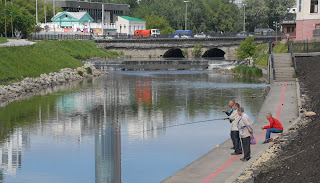Yekaterinburg, east of the Ural Mountains, is known for the Church on Blood in Honour of All Saints Resplendent in the Russian Land, a Russian Orthodox church built on the site of the Ipatiev House, where Nicholas II, the last Emperor of Russia, and his family, along with members of the household, were shot by the Bolsheviks during the Russian Revolution.
We're staying in the Chekhov Hotel, and have a couple of days to look around!
Ekaterinburg has a 'Red Line', like Irkutsk — in fact theirs is the prototype! The Chekhov Hotel, in ul. 8 Marta, is just a short walk from this red line, so you should know our plan of action by now!
A walk up ul. 8 Marta took us past the Bolshoy Zlatoust Church, remarkable because the Soviets demolished it in 1930 to make way for a statue of Lenin and Stalin. It was rebuilt in 2009, relying on old photographs and descriptions! Near this is the The House of Defence, built in the 1930s, and topped with a little red plane!
Further up ul. 8 Marta we turned into pr. Lenina (проспект Ленина, Lenin Avenue) and found the Square of 1905, commemorating an anti-monarchist rebellion in that year. Surprisingly, at least in the summer, it has been turned into a huge car park! It's in this square that you find the inevitable statue of Lenin! On the other side of the road you can see the impressive, Stalnist-style City Administration building.
We walked along pr. Lenina to the embankment of the City Pond, a beautiful lake in the heart of the city. (Later in our walk, in the Museum of Yekaterinburg's History, we found an illustration of the Pond as it was in 1795!)
Walking along the Pond's embankment — the oldest street in Yekaterinburg — we came across the 1880s' Water Tower (built to service the railway workshop which used to exist nearby) and the Monument to V.N. Tatishchev and V.I. de Gennin, recognised as the founders of the city.
Painting is a well supported activity here, and we caught a few painters near the Monument to the Founders, looking across the historic square, regarded as the physical heart of Yekaterinburg. There is still a river here, the Iset, which used to power the mills, but which now gives pleasure to the inhabitants with its play of fountains and the opportunity to go fishing right in the middle of the city.
We next crossed to the house on pr. Lenina and the east bank of the Pond, widely recognised as the most beautiful residence in Yekaterinberg. Now the residence of the President of the Russian Federation, it is known for the very rich civil servant N. Sevastyanov, who had the house renovated for his own home in the late 19th century.
We walked up the east bank of the Pond, passing a lot of interesting places that we'll gloss over in the interests of brevity. We finally got up to the furthest point in our walk, the Church on Blood in Honour of All Saints Resplendent in the Russian Land (Храм-на-Крови́ во и́мя Всех святы́х, в земле́ Росси́йской просия́вших), built between 2000 and 2003 on the site of the Ipatiev House, where the Romanov family were shot by the Bolsheviks during the Russian Civil War. Tsar Nicholas II and all his family found buried at this site have been sainted by the Russian Orthodox Church.
The interior is magnificent, but photography within is severely restricted. Warren, with his 'proper' camera was able to take only two or three photos, but our friend Cassandra was able to walk round with her mobile phone and not attract any attention. The shots in the crypt are thanks to her.
Turning back towards home, we passed the statue of a familiar figure (Tscaikovsky) before arriving at the Museum of Yekaterinburg's History, mentioned above. This is a very worth-while place to visit, as it puts a lot of the things we have been seeing into their proper perspective. For example, we learned that the city was founded at the behest of Peter the Great as a metalworking city to support the mining industry of the Urals. It has also been prominent in jewellery and perfumery, particularly in the 20th century.


We turned the corner into pr. Lenina (again) and went past the Musical Comedy Theatre, and a very severe building, the Printing House, built in 1930 in the constructivism style. The most interesting part of this building (to us) is that there is a huge bookshop in the basement — 100,000 Knig (100000 книг, 100,000 books). It's all on one level, and seems to go on for ever!
Opposite this is the Theatre of Opera and Ballet, a magnificent building which had its first season in 1912.
From here, with tiring legs, we decided to retrace our path back along pr. Lenina to a luxury shopping mall almost opposite The Square of 1905 (remember this?). Passage (Пассаж) carries all the top-line brands, and looks like it!
We left Passage fairly quickly and wandered down ul. Baynera (улица Ва́йнера), a pedestrian mall since 2003. This street is known for its quirky street sculptures.
Nearing home, we called past Grinvich (Гринвич — we've been thinking of it as 'Greenwich'), the shopping centre just round the corner from the Chekhov, where we have been taking our evening meals at a wonderful cafeteria on the top floor. There's another quirky statue outside this shopping centre!
And back to the hotel to prepare for another day!




























No comments:
Post a Comment